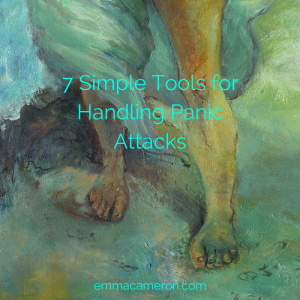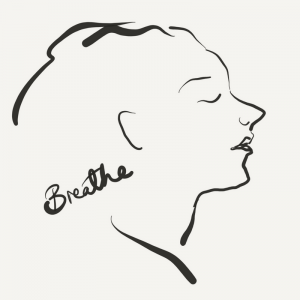Handling panic attacks: What’s the best approach?
There are loads of approaches that you can take to help yourself get better at handling panic attacks. Below are 7 simple tools that you can use with any kind of anxiety (and a panic attack is a severe kind of physical experience of over-active anxiety).
[Important note: Make sure you have already checked with your doctor to rule out any other health concerns. Some physical conditions such as PANS and Lyme disease can cause symptoms of extreme anxiety and panic attacks. Nothing in this post is intended to replace medical advice that you may have been given.]
[Another important note: For some people panic attacks, along with flashbacks, are a symptom of PTSD (post-traumatic stress disorder). In these cases it’s best, if possible, to also work with a therapist who is a trauma specialist and works in a relationally attuned way.]
First, I want to share the very best way to handle a panic attack.
This one is the ‘gold standard’ for panic attack treatment. In fact, this first method is so effective, that once you’ve used it a few times you will have retrained your brain not to get triggered into a panic attack.
1. Flooding
A panic attack treated using the flooding technique will typically last around 10 minutes. A panic attack treated using other techniques (such as trying to stop feeling panicky) will typically last three to six times as long. Here’s what you have to do with the flooding technique:
1 ) When you feel a panic attack coming on, sit down. Do not leave the place where you are, or you’ll train your brain to get more and more scared of being in that place.
2 ) Imagine you are glued to your seat. Do not get up! This will feel extremely uncomfortable; that’s normal.
3 ) Then, allow the physical sensations to flood through you. Imagine that the sensations are like massive waves crashing over and through you, like on a beach. Use words to label each physical sensation as you notice it. This will feel very uncomfortable. You’ll probably feel sweaty, your heart will beat fast, your chest and throat will feel tight, you’ll shake, you’ll have a general feeling of dread, you’ll feel weak, and you may even feel like you might die very soon.
4 ) Bear with it. Remind yourself that these physical sensations are not as dangerous as they seem. They are very temporary and a normal experience for someone who is having a panic attack. Keep imagining the physical sensations as waves washing through you. Feel the intensity, and allow it to happen, so you aren’t fighting it. After about 10 minutes (or less) the waves will subside – as long as you have really allowed the panic attack process to do its thing, without trying to fight it.
5 ) Be kind to yourself afterwards. Don’t tell yourself you’re weak or stupid. Instead, notice how brave and strong you have been, in sitting with those overwhelming sensations instead of running away from them or trying to stop them. (With panic attacks, running away or trying to stop the feelings only builds up more trouble for next time).
7 simple tools for handling panic attacks Share on X
Here are the other simple tools for handling panic attacks or other times when you start to feel really anxious. These ones all come under the umbrella of ‘grounding techniques’. If you want to read more about grounding techniques read my blog post ‘Ground Yourself: 12 Easy Ways to Get Calmer’
2. Breathe
When you feel worried and panicky, your breathing gets faster and shallower. This in turn makes you feel more and more anxious and off-balance. So start by paying attention to your breathing. Because breathing is such an ordinary activity, we don’t often realise the incredible power that breathing styles can have on the nervous system.
Breathe in slowly and fully through your nose, and notice your belly expanding (this is good – it shows your diaphragm, the sheet of muscle that separates your lungs from your digestive organs, is moving well). Hold the in-breath briefly if that feels comfortable, then breathe out slowly through your mouth, as if through a straw. Make sure the out-breath is as long as (or longer than) the in-breath.
You can add to this by thinking of the word ‘comfort’ on the in-breath, and the word ‘relax’ on the out-breath. (Substitute any calming words you like, such as ‘peaceful’, ‘calm’, etc)
Note: Once you’re already having a full-blown panic attack, trying to control your breathing may not be possible, unfortunately. So instead, do the Flooding technique described above.
3. Five Senses Grounding
Go through each of your five senses, 5 4 3 2 1:
- Eyes: Look around you, moving your head and eyes to really get a good view of your environment. Say out loud (or sub-vocally, just under your breath) the names of five things you see. Really articulate the words, maybe even picture the words spelled out in your mind.
- Ears: Now listen carefully for four things you can hear. Again, name them in words.
- Touch: Put your fingertips on three different things. Name the item, and see if you can also find words to describe the textures, such as ‘soft cheek’, ‘smooth wooden chair’, and ‘fuzzy sweater’.
- Smell: Can you detect two scents? Maybe a subtle trace of laundry detergent on your clothes, and the smell of a leaf or flower nearby. Some people like to have strong smelling sweets to help ground them when they are feeling panicky, like mints or Fisherman’s Friends.
- Taste: Use your tongue to explore the inside of your mouth. What tastes can you detect? Maybe now would be a good time to suck a sweet or take a sip of water.
This method combines several neuroscience-backed elements which bring in different parts of the brain and nervous system. These include putting words to experience, actively using your senses, and being ‘present’ in your surroundings in the moment (as opposed to spinning off into frantic imaginings of future disaster).
4. Eye roll plus Hand Squeeze*
First, the Eye Roll:
- Roll your eyes upward as if you are trying to look at the middle of each of your eyebrows. (Your eyes can be open or closed for this)
- At the same time as you roll your eyes up, breathe in slowly and deeply.
- Hold your eyes gazing upwards while you hold your breath for a short time.
- Relax your eyes and breathe out slowly, allowing your eyes to drift back to their original position.
Then, do the Hand Squeeze:
(You may like to close your eyes for this one)
- Imagine that all your difficult feelings and muscular tension are going into your dominant hand.
- Make a fist with that hand, squeeze it tightly, and notice how compressed and tense your hand feels.
- See if you can tighten and squeeze that fist even more.
- Imagine that tension becoming a coloured liquid, which represents all those uncomfortable feelings.
- Imagine your fist absorbing all the coloured liquid, all the difficult feelings and tension.
- Release your fist slowly, one finger at a time, and imagine the coloured liquid flowing to the floor and through the floor to the ground, to be easily absorbed deep into the earth.
- You can repeat squeezing your fist and releasing the tension again, noticing the difference between the feelings of tension and the feelings of relaxation.
- Repeat the exercise with your other hand.
5. Get Support from Somebody You Trust
If there’s anyone with you who you feel connected to, then they may be able to help you get grounded. Eye contact, soft vocal tones, hand-holding, and smiles, can all help you tap into what neuroscientists call your body’s ‘social engagement system’ (the ventral vagal branch of your autonomic nervous system) and get your nervous system back in balance.
6. Attention on Legs and Feet
This one is really simple! Either sitting or standing, plant your feet firmly on the floor or ground. Then direct your attention to any sensations you can feel in them. It doesn’t matter whether it’s aches, pain, warmth, heaviness, cold, tingling, pleasant feelings, or areas of numbness: be curious about it all. Notice any energy flows, and how the sensations may subtly change from moment to moment (if they do).
This exercise is complete in itself, but you may like to add to it by using your imagination to envisage energy going from your feet and extending deep into the ground below, a bit like tree roots. Then you can imagine these ‘roots’ tapping into the wisdom and timeless solidity of the earth, and bringing up nourishment to help ground you.
7. Chew Gum
Another simple one. Just chew gum! Apparently your body will get tricked into believing that you’re eating. And eating is one thing that doesn’t happen when there’s a genuine emergency situation. (The fight/ flight/ freeze response shuts down the digestive system). So chewing gum acts as ‘proof’ for your body that there is no need to panic.
I hope this has given you a starting point for helping you with handling panic attacks.
And do make sure you consult with your GP or primary care physician to make sure there are no medical issues contributing to your panic attacks. I also recommend working with a counsellor or therapist if you can, to help you develop your own personalised ways of understanding and handling your panic attacks. And a really good book that I recommend for people who suffer from anxiety is ‘It’s Not Always Depression’ by Hilary Jacobs Hendel. Another excellent self-help book is ‘A Liberated Mind’ by Steven C. Hayes.
As a psychotherapist and Art Therapist, I specialise in helping HSP’s (Highly Sensitive Persons) and other creative, thoughtful, sensitive people who suffer from anxiety. I work with people online (using Zoom, which is like Skype). I also provide individual Art Therapy and AEDP (Accelerated Experiential Dynamic Psychotherapy) near Colchester, Essex.
What are your favourite methods for handling panic attacks?
There are many more than the seven I’ve listed here. I’d love to hear about what you’ve found works well for you. Please let me know in the comments below!
*The Eye Roll and Hand Squeeze are adapted from Daitch, C. & Lorberbaum, L. (2016) The Road to Calm Workbook: Life-Changing Tools to Stop Runaway Emotions. New York: Norton. There is also an app available, ‘The Road to Calm Companion App’ that you can download to your smartphone.






Great ideas. I’ve found that on breathing out I imagine my negative feelings coming out my nosé and mouth as grey or black smoke!
That smoke visualisation sounds like it could be really helpful!
Thank you, this makes me want to go and try it out now, on a train!